by Aspirant Team
July 22, 2022
Recruiting is always evolving, but now, more than ever, it’s very clear that sourcing will re-emerge at the core of the transformation. And here’s why:
Over the past several years — or maybe I should say decades — of working with organizations around the world to develop their talent sourcing capabilities, many of our first engagements were initiated to find what we once called “a purple squirrel” — an individual with unique and hard-to-find skill sets that made these candidates elusive to recruiters.
These types of candidates and the effort involved in finding them had a dramatic impact on recruitment metrics. At first, hiring speed, accuracy, and efficiency took drastic hits. But on the other side of this challenge was a positive outcome: sourcing began to transform and evolve the organization’s recruiting function, proving that using sourcing techniques to find this unique talent was worth the effort and it became a strategic imperative for many organizations.
Every company can cite the challenges they have when it comes to recruiting such as geographical location, industry and industry-specific skills, company culture, and recruiting teams. Likely, their recruiting style is a result of those challenges. But an organization’s “standard recruiting M.O.” can also be a good measure of its maturity, agility, and competitiveness in the talent market.
Recruiting programs are either reactive or proactive. Traditional recruitment programs most often fall in one of three common operational models that are reactive in nature.
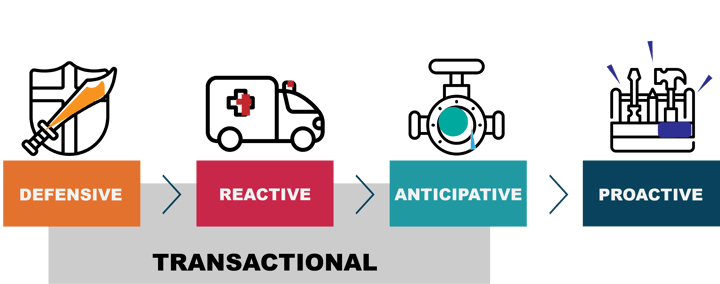
The first operational model, I’ll call Defensive Recruitment.
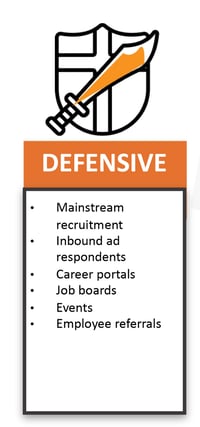 This recruitment model is known for “post and pray” or “pay and spray” techniques that rely on widely broadcasting job advertisements so candidates to come to you. Most traditional organizations operate in this defensive mode; their candidate outreach includes recruitment marketing, posting to job boards, promoting referral programs, and hosting events. Defensive recruiting is about waiting for something to happen before taking action therefore relies primarily on the candidate taking the initiative and “doing the work” of making the connection. And while Defensive recruiting produces the kind of high-volume candidate flow that is appropriate for some roles, the more options a candidate has, the less likely they are to invest time in such a process.
This recruitment model is known for “post and pray” or “pay and spray” techniques that rely on widely broadcasting job advertisements so candidates to come to you. Most traditional organizations operate in this defensive mode; their candidate outreach includes recruitment marketing, posting to job boards, promoting referral programs, and hosting events. Defensive recruiting is about waiting for something to happen before taking action therefore relies primarily on the candidate taking the initiative and “doing the work” of making the connection. And while Defensive recruiting produces the kind of high-volume candidate flow that is appropriate for some roles, the more options a candidate has, the less likely they are to invest time in such a process.
Broadcasting jobs can result in a large volume of inbound applicants who must be filtered, sorted, and screened. Combined with a long or awkward application process the reliance on screening and background checking means recruiters take on administrative roles processing applicants and have less time to spend on adding value to the hiring process. Past applicants are ignored for future openings and control is left in the hands of outsiders as employers wait and hope that enough qualified applicants arrive.
The second operational model is Responsive.
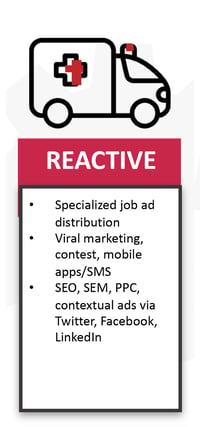 While there are still many aspects of this model that require the candidate to come to you for first contact, Responsive companies have figured out that conventional recruiting methods are insufficient to attract top candidates and will invest considerable time and effort in creating targeted means of attracting them, or they spend time finding candidate resumes on major job boards to reach a wider pool of talent.
While there are still many aspects of this model that require the candidate to come to you for first contact, Responsive companies have figured out that conventional recruiting methods are insufficient to attract top candidates and will invest considerable time and effort in creating targeted means of attracting them, or they spend time finding candidate resumes on major job boards to reach a wider pool of talent.
Hallmarks of this model are a reliance on pay-for-results specialized job distribution to niche job boards, viral marketing, mobile apps, SEO/SEM, and pay-per-click advertising or programmatic ad buying. While very functional, this model is laborious, costly, and time-consuming. Employers do this to survive or may end up outsourcing their recruitment process.
The third operational model is Anticipative.
In the Anticipative recruitment model, recruiters are aligned to specific business segments and pipeline potential candidates ahead of demand but still wait for a requestion to begin the process of connecting with them. They get involved with the hiring manager to plan for the job to be open and may even have a database of contacts they can reach when the right opportunity comes around. Delays cause some high-quality candidates to be snapped up before these recruiters can approach them for a role.
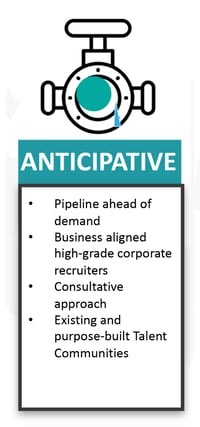 For “hard-to-fill” roles that are high level yet of low criticality, or roles that are unlikely to recur frequently, turning to agencies shifts the labor burden and increases the speed to hire at the price of raising costs. Time is critical in recruiting. Searching a database for qualified candidates can take hours each day. In this model, a recruiter can view hundreds of resumes and find perhaps one or two candidates who qualify. This is a labor-intensive process that lowers the yield per recruiter. The cost incurred in paying for more resumes, and then paying more people to read them, makes this model attractive to contingency-based firms who can afford to specialize in niche areas and work with a wide spectrum of clients with similar hiring needs, thus maximizing their investment. When a good candidate in this quadrant decides to job hunt, there is only a short window to obtain their attention before they are considering other offers. So, if a recruiter does not connect with the candidate when they begin their consideration of a new opportunity or are still looking, all effort is wasted.
For “hard-to-fill” roles that are high level yet of low criticality, or roles that are unlikely to recur frequently, turning to agencies shifts the labor burden and increases the speed to hire at the price of raising costs. Time is critical in recruiting. Searching a database for qualified candidates can take hours each day. In this model, a recruiter can view hundreds of resumes and find perhaps one or two candidates who qualify. This is a labor-intensive process that lowers the yield per recruiter. The cost incurred in paying for more resumes, and then paying more people to read them, makes this model attractive to contingency-based firms who can afford to specialize in niche areas and work with a wide spectrum of clients with similar hiring needs, thus maximizing their investment. When a good candidate in this quadrant decides to job hunt, there is only a short window to obtain their attention before they are considering other offers. So, if a recruiter does not connect with the candidate when they begin their consideration of a new opportunity or are still looking, all effort is wasted.
The fourth operational model is Proactive.
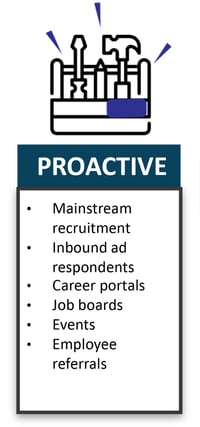 Organizations that use this strategic approach usually designate approximately 20% of their positions as "critical" roles - those are roles that will impede business growth should they go unfilled for any length of time and require a unique approach to find the right candidate. What sets this operational model apart is the use of expert researchers and callers to conduct lead generation and identification based on talent profiles in advance of a requestion. This makes the relationship between the recruiting team and hiring manager more consultative, rather than a “customer/order filler” relationship that is more prevalent in more reactive models.
Organizations that use this strategic approach usually designate approximately 20% of their positions as "critical" roles - those are roles that will impede business growth should they go unfilled for any length of time and require a unique approach to find the right candidate. What sets this operational model apart is the use of expert researchers and callers to conduct lead generation and identification based on talent profiles in advance of a requestion. This makes the relationship between the recruiting team and hiring manager more consultative, rather than a “customer/order filler” relationship that is more prevalent in more reactive models.
Proactive teams also place a high value on re-hiring eligible former employees, non-employee referrals, and revisiting “silver medalists” - candidates who declined offers or were close contenders for hire, yet ultimately were not selected for a specific position and could be better suited for the new opening.
Sourcing as part of a proactive hiring strategy saves you time, money, and effort. It creates efficiency, reduces redundant efforts, and keeps pressure off you, your team, and your hiring manager, too. And it helps the business be more agile and competitive for talent, today and in the future. It also helps to elevate your employer brand beyond waiting for candidates to encounter your brand in job board messaging.
Obviously, these models are not mutually exclusive: many recruitment organizations are host to two or more of these models at any given time due to various business pressures or environmental factors. But the further an organization moves into the proactive, more strategic model, the more value it adds by driving the very future of the organization through talent.
Companies with a more proactive recruiting model are those that consistently achieve their top potential in terms of talent. With a sourcing team focused on long-term candidate development, these companies are often known as employers of choice within their industry or region. They’re also able to attract top performers from their competitors and outside of their industry. They discuss strategies for meeting company growth needs or replacing key employees and the team is updated continually on planned changes in the business that will impact talent needs.
Such an environment enables forward-thinking, pipeline-based, proactive models capable of leveraging technology and automation to recruit and prime a talent pipeline ahead of demand. By automating low value-added tasks through the use of technology, knowing where the talent is, and knowing how to get to it, this model decreases cost and increases speed. More nimble employers benefit from access to candidates that move quickly.
Strategic Talent Sourcing consists of industry experts with low requisition volume focused on building critical talent pools and supporting all requisitions with low or no candidate flow. While a relatively small percentage of an organization’s hires are critical, these are the jobs that remain unfilled the longest, cost the most to fill, and when they go unfilled, highly impede growth. Hiring organizations generally agree that to fill these jobs they must turn to sourcing.
Recruiting organizations don’t “mature” overnight. If your team is using a Defensive or Reactive hiring model, it may take quite a while to see your team evolve. But an investment in sourcing will greatly increase your organization’s capability to consistently hire more A-players.
As I shared, I’ve worked with hundreds of hiring organizations over the years—big and small—and have found that those that mature and evolve most rapidly are those with one very important attribute in common: deeply integrated into their sourcing strategies are five key components aligned with the business and ever-evolving to meet its needs.
Team Architecture: Does your team structure make the most effective use of their skills, resources, and technology? And are your roles well-defined, or do you have team members that are stretched too thin to become effective?
Direct Sourcing: What percentage of your hiring is for critical roles? The A-list talent you’ll need to fill them is waiting for your opportunity to come to them. Do you have the skills in place to find and connect?
Metrics that clearly demonstrate ROI: What’s your team’s most important outcome? Is it being adequately measured? What metrics should you have to measure performance or value to the organization?
Skill Development: Do you have the resources in place to ensure your sourcers’ advanced web search techniques are up-to-date? Where do they get the expert advice they may need to accelerate their results?
Sustainability: Must team members re-invent the wheel at every turn? How is organizational wisdom shared? Companies that create a sourcing center of excellence (CoE) and champion subject matter expertise grow their teams’ skills and knowledge exponentially.
While evolving your recruiting model by investing in a proactive sourcing strategy isn’t always easy, studies estimate that companies that have made the transition from a Reactive Recruiting Model to a Proactive Sourcing Model increase hiring performance by 30% or better.
By looking at the skills and talent in your talent acquisition function today, Talent Acquisition organizations can take action that better prepare their company for tomorrow’s hiring needs. Through Aspirants Sourcing solution, we offer a detailed diagnostic tool that can reveal where TA leaders need to focus in order to optimize their sourcing strategy and help their team more effectively serve their business. Whether you are looking to design a custom in-house sourcing model, strengthen and develop your current team, or wish to add staff to augment your own team, our solutions can help your strategy have the business impact it was designed to achieve.
If you’re ready to transform your recruiting team into the strategic hiring organization you need for the future, we can help. Connect with us to learn more.